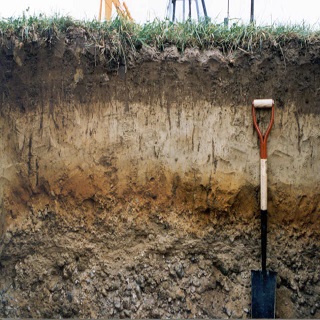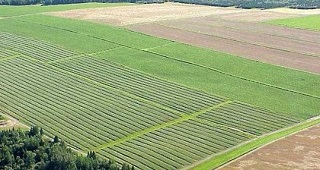Agriculture
Type of resources
Topics
Keywords
Contact for the resource
Provided by
Years
Formats
Representation types
Update frequencies
status
Service types
-

The “Biomass Inventory Cartographic Layer” dataset provides the information that is used with the Biomass Report Framework to generate a visual representation of the availability of agricultural and forestry biomass and municipal solid waste in Canada. In addition to yield and production information for biomass produced by the agricultural and forestry industries, this dataset also provides information about the demand for agricultural residues for cattle feed and bedding, tillage systems currently in use on agricultural lands, and land suitability for hybrid poplar and willow plantations that are grown specifically to produce biomass. Agricultural information includes the median annual residue yield and available residue amounts. Residue yields were calculated using crop-to-residue ratios. The available residue information includes the amount that is available after adjusting for the estimated demand of straw used for cattle feed and bedding. Forestry estimates include average residue production, based on forestry activities including permitted amounts of harvesting, mills in operation and mill production. Municipal Solid Waste information includes organic waste (food and yard), paper waste and total residential municipal solid waste (which includes organic and paper waste, among others).
-

The “Biomass Agriculture Inventory 1-in-10 Probability” dataset is a table that contains the estimated 1-in-10 year low for agricultural residue yield and crop production for each Biomass Report Framework. It provides the tenth percentile values for the years 1985-2016. The table includes straw or stover information for barley, wheat, flax, oats and corn, and crop information for barley, wheat, flax, oats, corn, canola and soybean. This dataset also includes information about the type of tillage used in the area and demand for straw for cattle bedding and feed. These values are derived from Statistics Canada data. Additionally, the dataset includes the amount of agricultural residue calculated as necessary to remain on the field to prevent soil degradation. Soil degradation is determined by the type of tillage in use as well as the landscape of the area.
-

The “Municipal Solid Waste Biomass Inventory” dataset is a stand-alone product that provides information on the calculated amount of Municipal Solid Waste within each BIMAT grid cell that includes a population centre. Data was provided by National Research Council Canada, with estimates based on census data collected in 2016. This dataset was calculated using an area-weighted analysis between population centres across Canada, Municipal Solid Waste data and the Biomass Report Framework fishnet. It includes information for total residential municipal solid waste, total organic waste (food and yard) and total paper waste.
-

This dataset is no longer maintained by Agriculture and Agri-Food Canada and should be considered as an archived product. For current estimates of the agricultural extent in Canada please refer to the Agricultural Ecumeme produced by Statistics Canada. https://www150.statcan.gc.ca/n1/en/catalogue/92-639-X The Agriculture Extent of Canada derived from the AVHRR (Advanced Very High Resolution Radiometer) was obtained from the GeoGratis web site (www.geogratis.ca). All polygons with an area less than 50 Km sq were eliminated by GeoGratis before we received the data. This product allows the user to see the significant areas of cropland and rangeland across Canada. The Agriculture Extent of Canada derived from the AVHRR (Advanced Very High Resolution Radiometer) was obtained from the GeoGratis web site (www.geogratis.ca). All polygons with an area less than 50 Km sq were eliminated by GeoGratis before we received the data. This product allows the user to see the significant areas of cropland and rangeland across Canada.
-

This dataset is a rasterized version of the Soil Landscapes of Canada (SLC) dataset. Soil attributes in this dataset have been collated from SLC map polygons and follow the GlobalSoilMap.net standards and specifications at specified depth increments extending over the agricultural portion of Canada. Weighted averages of soil attribute properties are generated from existing soil horizon information to conform to recognized fixed depth increments. Soil attribute weighted means are calculated by using all the soil components based on their areal extent within each SLC polygon. The weighted mean averages of attributes are spatially represented by the grid along with the lowest and highest attribute values found within each polygon.
-

This data shows spatial density of oats cultivation in Canada. Regions with higher calculated spatial densities represent agricultural regions of Canada in which oats are more expected. Results are provided as rasters with numerical values for each pixel indicating the spatial density calculated for that location. Higher spatial density values represent higher likelihood to have oats based on analysis of the 2009 to 2021 AAFC annual crop inventory data.
-
Les Silos à grains du Canada – jeu de données contient la liste des silos à grains au Canada telle qu’elle est communiquée par la Commission canadienne des grains (CCG). Les silos ont été localisés dans toute la mesure du possible selon leur emplacement réel, plutôt qu’une généralisation au point milieu du nom de la gare. De plus, l’information relative aux places de wagons du CN, du CP et des entreprises céréalières a été ajoutée lorsqu’elle a été publiée. Le présent jeu de données vise à offrir l’étendue temporelle et géographique des silos à grains au Canada. www.agr.gc.ca/atlas/metadonnees/5e0b5778-80cd-4697-8b84-23b4a814c1ae
-

Crop rotation is an agricultural production and land management practice beneficial to sustainable agriculture in Canada. Agriculture and Agri-Food Canada (AAFC) produces crop rotation data annually showing the crop rotations used within the agricultural extent of Canada for the last four complete growing seasons (based on available data). This data can be used by producers, land managers, and policy makers to assess current rotations to assist in future land management decisions.Crop rotation data is derirved from AAFC's publicly-available annual crop inventory data.
-

The “Biomass Agriculture Inventory 1-in-20 Probability” dataset is a table that contains the estimated 1-in-20 year low for agricultural residue yield and crop production for each Biomass Report Framework. It provides the fifth percentile values for the years 1985-2016. The table includes straw or stover information for barley, wheat, flax, oats and corn, and crop information for barley, wheat, flax, oats, corn, canola and soybean. This dataset also includes information about the type of tillage used in the area and demand for straw used for cattle bedding and feed. These values are derived from Statistics Canada data. Additionally, the dataset includes the amount of agricultural residue calculated as necessary to remain on the field to prevent soil degradation. Soil degradation is determined by the type of tillage in use as well as the landscape type of the area.
-
This dataset is aligned to a grid that with a dataset of soil attributes following GlobalSoilMap standards and specifications at specified depth increments extending over the agricultural portion of Canada. The SLC map polygons were rasterized and combined with the Shuttle Radar Topography Mission (SRTM) 90 metre grid to create the gridded raster dataset. Weighted averages of soil attribute properties are generated from existing soil horizon information to conform to recognized fixed depth increments. Soil attribute weighted means are calculated by using all the soil components based on their areal extent in each SLC polygon. The polygonal attribute weighted mean averages are spatially represented by the grid. For more information, visit: http://open.canada.ca/data/en/dataset/cb29b370-3639-4645-9ef9-b1ef131837b7
 Arctic SDI catalogue
Arctic SDI catalogue